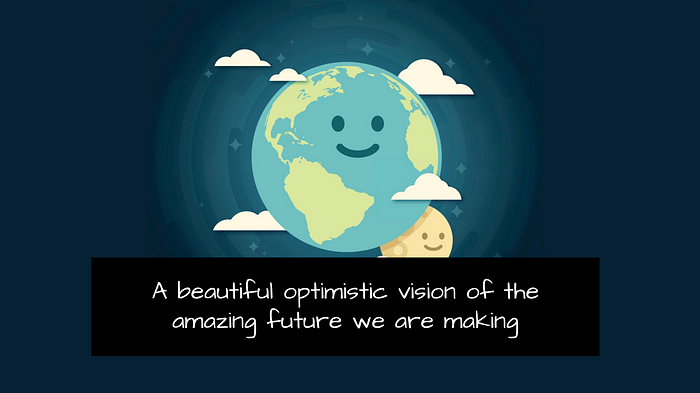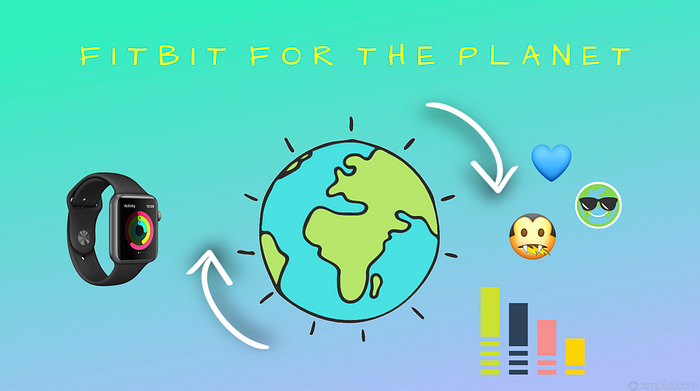Why Optimism and Creativity (Not Doom) Will Save the Planet
When we talk about the future of planet Earth, we hear stories of devastation and doom. While it’s necessary to understand the science of environmental damage, we’ve been painfully missing a vision for the world we *do* want.
When we talk about the future, there is a lot of talk about doom. Not the 1993 video game—but doom for planet Earth.


We see pictures of burning Earths, diabolical climate charts, plastic filling up the ocean — and then there’s that harrowing video of the sea turtle with the straw stuck in its face.
Here are some images that typify a common look and feel produced by the environmental movement: the Earth on fire, a zombie stag made of trash, a human face deformed into a fish head, and the most disturbing of all — a human baby as a sea turtle about to be knifed. Seriously?
These images reveal how much of the environmental movement’s messaging has been predicated on a story of doom.

I’ve been watching the doom messages for 30 years now, since I was eight years old and I saved my pocket money to buy a mug from Greenpeace to help save the dolphins—and I’m done with doom.
There’s a better way to do it
I think there’s a better way to change the world. There’s a new way that doesn’t fill me (or anyone else) with fear and dread of the apocalypse. Instead, this way fills me with wonder and ideas.
It’s simple, but it’s deep — we need a beautiful optimistic vision of the amazing future we are making.

There’s a saying in politics, “It’s not what you’re against. It’s what you’re for.”
Amongst the onslaught of negative news about our planet, this vision has been painfully missing. The environmental movement hasn’t had a strong vision for “what we are for.”
This is the kind of world I'm talking about
Let me share a dramatic contrast to a world illustrated by scary red-lined charts and ominous climate headlines. Here’s an example of how beautiful the future could be.

Imagine if the world’s cities grew out of the age of pollution and smog and evolved into rolling eco-scapes, patchworked with green roofs, and orchards nestled into parks. Vegetable gardens could cascade off the sides of city buildings, so you could put your arm out the window and pick a cucumber and make a salad.


Imagine walking downtown in your city and everything smelled good — like a forest. Freeways got taken out and replaced with electric trains, bike paths, and green bridges for animals like deer, rabbits, or koalas to walk across.

Imagine a future world where we are done with plastic waste and junk and our next generation of children grew their own fruit and vegetables at school. A world where amazing vegan food is everywhere in compostable packaging and landfill has become extinct. And in this world, we’ve finally got it together to leave the fish and the dolphins in the ocean alone.
Think of a new age when science, technology, and manufacturing grew in symbiotic partnership with nature, instead of growing at the expense of it.
And imagine the day when the sun sets on the age of fossil fuels, and the sun rises on a billion solar panels that power our new world.
It’s already happening
Sounds amazing, right? And just in case you thought it sounds like a fairy tale, here’s some evidence that it’s already happening: expensive solar panels, smoke in the air, and child mortality have all been dropping rapidly, and protected nature is going up.

This concrete two-story mega-freeway in South Korea got taken out 10 years ago and replaced with this enormous green nature waterway.

Even carbon dioxide emissions — the big issue of our time — are going down in the USA and in almost every developed country.

So what’s stopping the dream come true?
Even though change is sprouting up all around, there’s still a giant obstacle in front of us. I don’t think this obstacle is greed or mega-corporations or all those kind of things we hear of — all the things we are against.
I believe what will power us over the obstacle to achieve this world is:
1. Imagination,
2. The vision of what we want, and
3. The creativity to make that vision happen.

If you think these three words sound flakey or soft in the context of major world problems — like you can’t just macrame your way to a carbon-neutral economy, right?
Hear me out, because I’ve spent a lifetime trying to understand how to save the Earth— as an environmental engineer, green building designer, a tech startup founder — I even just wrote a book literally called How to Save the World and I’ve read hundreds of academic papers on the psychology of how to get people to pro-environmental things.
What I found at the bottom of all the technology and politics and blame is that it is vision and creativity that drives change.
It goes deeper than you think. Let me explain.
Social movements, leadership, and action are built on a vision
French aviator and writer, Antoine de Saint-Exupery once wrote, “If you want to build a ship, do not drum up the men to gather wood, divide the work and give orders. Instead, teach them to yearn for the vast and endless sea.”

A vision that you articulate unleashes the dream, not just in you, but in everyone else around you.
This is why Martin Luther King’s I have a dream speech was so powerful, because the speech was constructed from a visualization of the positive future — and he used those magical words “ I have a dream . . .”

We need less “I have a nightmare” and more “I have a dream.” The nightmare story alone is not powerful enough to give us the emotional energy to change.
My own lifetime of having a vision for a new world
One of my earliest childhood memories when I four years old was of my mother and I taking a trip to the city. I remember looking out the back window of our little white 1980s Volkswagen. I was shocked by the gritty ugliness of inner city: industrial overhanging train lines, grimy buildings, soot that leaks down from the roof — it was an eyesore.

Every time I saw it, I thought “Why have all the grown-ups not covered all this nasty junk with morning glories?” Not any other flower— specifically the purple morning glory. It was a vine. It could be grown over anything easily. Obviously, at four years old, I knew it was the solution.
I always had this imagination of seeing urban grime reimagined as a world covered in living moss, ferns, and flowers. Ever since my earliest childhood memories, it never went away.

When I was 21 years old at university in downtown Melbourne, I would look out at the city and imagine trees growing out of the tops of all the buildings.
A few years later I started a media company and I would look through magazines and imagine the humble world of sustainability becoming cooler than Nike and more fashionable than Chanel.
Then I moved to Silicon Valley and I imagined a new age where we’d use sensors and data to deeply understand and care for our Earth.

I never stopped seeing the world in two layers — like a transparency of the new world layering over the old.
I recently got inspired and made this poster for an idea for a documentary about all this called IMAGINE a New Earth. I posted it to Twitter and I was overrun with comments and messages — it was the most popular thing I’ve ever posted.

From that post, I could really see, at a deep soul level, how we are craving a new story for a future we can believe in.
You should try it
You’ve heard my version of “I have a dream” — so what’s yours? What’s the vast and endless sea you would ask people to join you on? What would you write on a notepad that had the words “I have a dream” penned at the top of the page?

This is an exercise from my book How to Save the World. Download the exercises in a free chapter called “Visualise Your World.”
A vision manifests optimism — and optimism is a superpower
Your future vision has a secret superpower . . . it’s optimism. Think of optimism like a vitamin.
Study after study has shown that optimism is good for you. Optimists work harder. Optimists make more money, optimists are healthier, and optimists even live longer.
Optimists are better at achieving their goals because they don’t give up.
When it comes to changing the world, being optimistic about the future of climate change, or democracy, or food — doesn’t mean living in a bubble of complacency. It’s believing that you can achieve a goal, and having the fire of motivation in you to make that dream happen.
Optimists are also happier.
That’s because, in the neuroscience of the brain, optimism creates dopamine — the chemical responsible for happiness, and motivation.

Happiness is a direct function optimism — it’s the anticipation of a good thing about to happen. Do you know what day of the week people are the happiest? It’s a Friday, because people are positively anticipating the weekend.
A happy mood is important for problem-solving
Happiness matters in our quest to save the world because a positive mood helps us to solve complex problems and to come up with great ideas.
Feelings like fear, doom, and helplessness are really bad for the brain. They activate the amygdala — the part of the brain that responds to stress and goes into fight-or-flight. The amygdala releases chemicals that shut down the prefrontal cortex — that’s the mental sketchpad of the brain.

When this happens, you lose about thirty percent of your cerebral brain function and your capacity creative thought gets turned off. Researchers say that functioning in this state is like looking at the world through a tiny pinhole.
Stress shuts off imagination and ideas
Just being “busy” even inhibits the part of the brain the imagines new ideas.
Active behavior happens in what’s called the brain’s central executive network.
Imagination happens in a completely different neural architecture called the default mode network. It activates when you stop doing things — when you relax and daydream. It’s this network that will imagine the details of your “I have a dream” future and may unlock your greatest ideas yet.
Innovation requires a mental model
The first step in making anything is visualizing a mental model of what you want to make. Think of how an architect imagines a new building, or a dressmaker imagines a gown.

Before they get to work — in their mind — they build an intricate and highly detailed mental model of their project. Creative people are particularly talented at this.
Then comes the second part — they reverse engineer their vision into reality and do all the practical things, to bring this visualization into existence.
It’s in this dance between imagining and making and imagining and making that is the guts of the creative process of bringing an idea, and this new world to life.

My creative journey
I’m an environmental engineer now, but I spent my childhood doing art. My mother introduced me to all the creative mediums. We did clay, silk screening, FIMO, china painting, slip casting, sewing, knitting, drawing— we did it all. I didn’t have a lot of friends, and our family had difficulties, but despite it all, I made things.
I spent my childhood constantly bridging the gap between imagining and making — whether it was a dress I sewed or a clay fish I molded. So when it came to saving the planet, I had this almost naive confidence that I could actually make all my ideas happen.
It’s in this gap where so many people are stymied by the story of doom.
If you’re dooming-out on the apocalypse — you’re not imagining or making anything useful.
Dooming out happens in what’s called the neurotic imagination. It’s the bad kind that ruminates over and over on everything that could go wrong.
To build the world of our dreams, we need to get out of the neurotic imagination and into the driver’s seat of what’s called the positive constructive imagination.
We need the positive constructive imagination
When we are talking about the planet, we might call it the environmental design imagination. Cool phrase, right? It may just be the answer to our planetary woes.

The environmental design imagination needs to do some pretty crazy cerebral feats, like imagining what it would take to cover a whole city in vegetation, or unraveling how carbon emissions affect the economy. It needs to produce an abundance of new ideas — everything from high tech bamboo water bottles, to 3-wheeled electric scooters, to big satellite-driven data systems.
We must reverse-engineer the future
This isn’t just about making good vibes or cute ideas — when I’m talking about creativity and imagination, I’m talking about tacking THE biggest engineering design challenge that ever was.
Building a modern human civilization that can exist harmoniously and sustainably on the planet requires a vast civilization-wide revolution in all our infrastructure, our factories, our farming, our scientific research, our electricity grid, the way we teach our children, the way we eat — it all needs to be redesigned.

And that challenge in front of us is more complicated than going to the moon and it’s a far greater design challenge, and it’s way more exciting than going to Mars.
Imagining this future and making it happen — that is the process of literally reverse-engineering the future.
Healthy optimized brains can change the world
Which brain will get us there? The small neurotic brain, riddled with stress, trapped within the confines of the problem, looking out through a tiny pinhole? Or the big optimistic constructive brain that is high on ideas and dopamine?

A commitment to creativity has transformed my ability to make change happen
These days I design software to save the planet. I do it by connecting a goal with a measurable action we can take now — and I try and make it as fun as a game or what I like to call a “Fitbit for the planet.”
It makes changing the world like a giant a puzzle and it’s really fun.

It started to get really good for me when I committed to doing this one thing. Three years ago, I was pushing my toddler in a stroller up a very steep San Francisco hill. I was exhausted and I was listening to this audiobook called The Big Leap by psychologist, Gay Hendricks.
He says that you should make time every day for what he calls you “zone of genius.”
So I did what he said and committed to spend one or even three hours in my creative genius zone. It was nothing glamorous — just putting my alarm on at 6am in a tiny bedroom with a toddler asleep next to me. I’d open my computer and ask this question “How can I channel my creative energy in a way that makes the greatest contribution?”
It didn’t happen overnight and it wasn’t easy, but since that day on that hill, I have produced the best environmental world-changing work of my life. Instead of having a knawing itch inside me that something in my soul is not sitting right, these days I spend each day living from the center of my life’s purpose.
When we step into our own creative genius, we step onto an upward spiral where changing the world isn’t a fight or a sacrifice. Instead, it becomes your greatest art form — and it’s in this circle where we do the greatest work of our lives that can change the world.

We do it by practicing three things:
- Imagine the future, peacefully in all it’s beauty and detail.
- Make time every day to invest in your creative genius.
- Distill your vision into actions you can take now that make measurable change.
Hatching out of our infancy

I don’t believe we are hurtling toward doom. I believe we are only just hatching out of our infancy.
Now I have a little girl of my own and she’s four. Now I’m teaching her how to imagine and how to make. I see so clearly now how we need to show her generation, and our generation, how to not see ourselves victims of the future — but to create the future like it is a canvas and we are the artists.
And that’s a dream I can really get behind — that imagination put into action is what will save the world.
Keep learning with my book “How to Save the World”
I find the psychology of environmental change so compelling that I wrote a book about it, called How to Save the World. Forbes Magazine ranked it the top five books for social change entrepreneurs. Order your copy today through Indiegogo or get it on Amazon and get more free material about how to apply behavioral psychology and game design to your cause at katiepatrick.com and on my Twitter, Instagram, and Linkedin.


